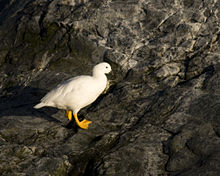- Kelp Goose
-
Kelp Goose 
Conservation status Scientific classification Kingdom: Animalia Phylum: Chordata Class: Aves Order: Anseriformes Family: Anatidae Subfamily: Tadorninae Genus: Chloephaga Species: C. hybrida Binomial name Chloephaga hybrida
(Molina, 1782)Subspecies - C. h. hybrida (Molina, 1782)
- C. h. malvinarum (Phillips, 1916)
The Kelp Goose (Spanish: Caranca or Cauquén Marino), Chloephaga hybrida, is a member of the duck, goose and swan family Anatidae. It is in the shelduck subfamily Tadorninae. It can be found in the Southern part of South America; in Patagonia, Tierra del Fuego, and the Falkland Islands.
Contents
Habitat
Kelp geese inhabit areas of southern Chile and Argentina, mainly in Patagonia, Tierra del Fuego, and the Falkland Islands. They habitat rocky coasts around their food sources.
Description
Males are a white color, with a black beak, and yellow feet. The females are dark brown, with transverse gray lines on the chest, and yellow feet.[1][2]
Behavior
Kelp geese generally have clutches of 2-7 eggs. They prefer to hide their eggs in long grass. The eggs hatch about a month later.
There are about 15,000 breeding pairs in existence.[2]
Ecology
Kelp geese are noted for only eating kelp and will migrate along the coast of South America in order to find kelp, hence the name 'kelp geese'.
Trivia
In the Falkland Islands and Argentina there are kelp geese stamps.
-
Female on East Falkland
References
- ^ ""Birds of the Falkland Islands: Kelp Goose"". http://www.falklands.net/BirdGuideKelpGoose.shtml. Retrieved 2007-05-09.
- ^ a b ""Kelp Goose"". Archived from the original on 2007-05-03. http://web.archive.org/web/20070503183651/http://www.avesdechile.cl/048en.htm. Retrieved 2007-05-09.
External links
- BirdLife International (2004). Chloephaga hybrida. 2006. IUCN Red List of Threatened Species. IUCN 2006. www.iucnredlist.org. Retrieved on 11 May 2006.
Categories:- IUCN Red List least concern species
- Geese
- Chloephaga
- Birds of Argentina
- Birds of Chile
- Birds of the Falkland Islands
- Birds of Patagonia
- C. h. hybrida (Molina, 1782)
Wikimedia Foundation. 2010.




